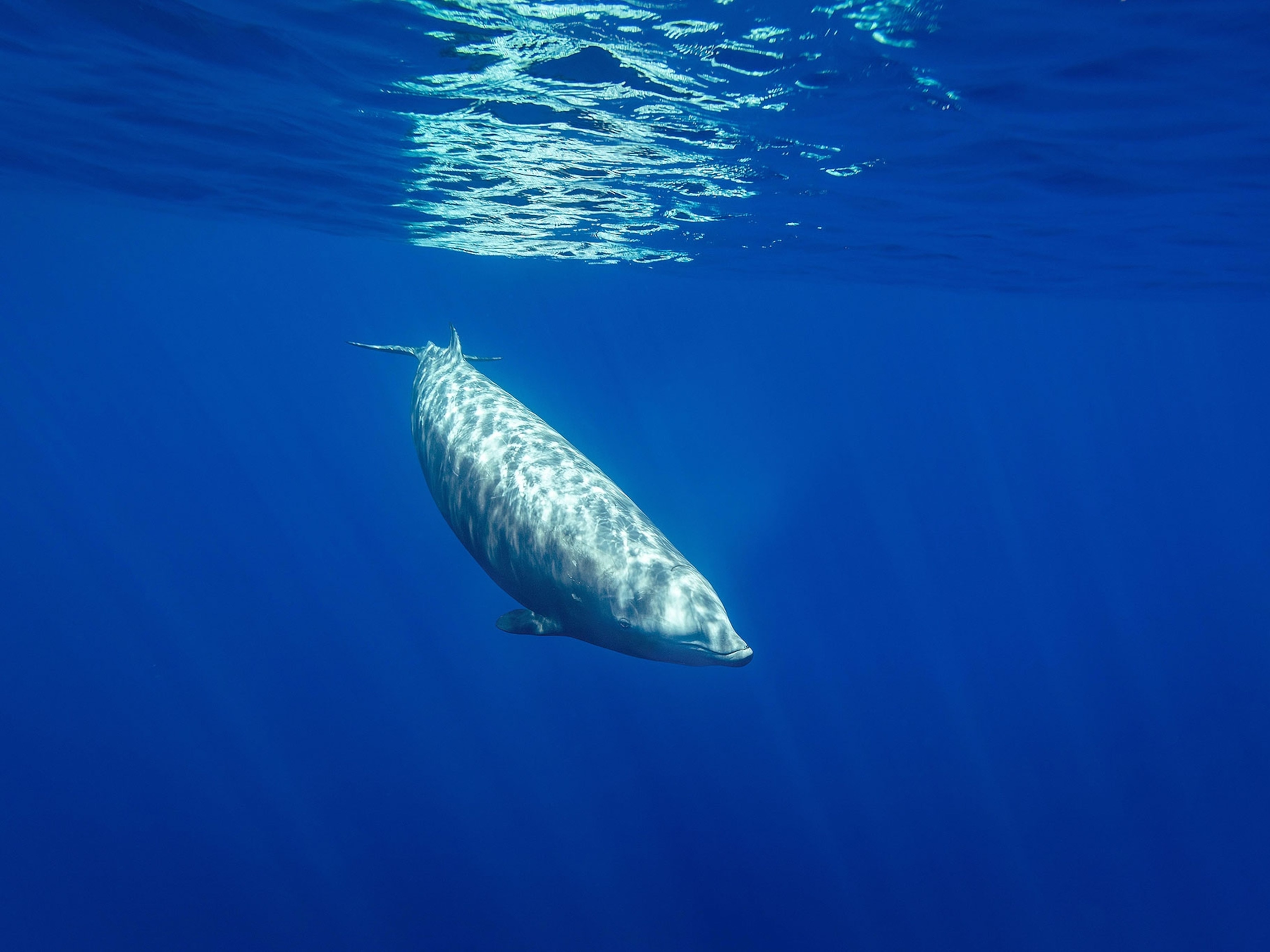
Supersonic Skydive's 5 Biggest Risks: Boiling Blood, Deadly Spins & Worse
This week, Felix Baumgartner will attempt highest ever free fall.
Update: Felix Baumgartner's Red Bull Stratos jump has been delayed until at least Sunday due to strong winds.
If all goes as planned this week, Felix Baumgartner will step off a small platform and skydive into history.
Baumgartner will climb to around 23 miles (37 kilometers) above New Mexico in a pressurized capsule attached to history's largest helium balloon—55 stories tall and as wide as a football field. When the weather is right and all systems are go, he'll exit the capsule in a pressurized suit and free-fall to Earth.
Seven years in the making, the so-called Red Bull Stratos Mission to the Edge of Space is expected to break records as the highest, fastest, and longest-duration skydive.
Baumgartner's team estimates the Austrian sky diver and helicopter pilot will reach Mach 1.2—roughly 690 miles (1,110 kilometers) an hour—and free-fall for five and a half minutes before opening a parachute at 5,000 feet (1,524) to float him to the ground.
Originally scheduled for Monday but postponed due to projected high winds, the feat would make him the first human to break the sound barrier without the propulsion, or protection, of a vehicle.
The current free fall record is held by Joseph Kittinger, a retired U.S. Air Force colonel and current Red Bull Stratos team member, who fell 19.5 miles (31.3 kilometers) on August 16, 1960. (See classic pictures of Kittinger's skydive.)
Kittinger, after years of refusing to help see his record broken, is now enthusiastically behind Baumgartner. "I felt that he was dedicated, that he was sincere. He's a trained athlete, he's an aviator." They have a special bond.
"I'll be the only one that knows exactly how Felix feels at that moment when he jumps from the step, 'cause I've done it," Kittinger says in Space Dive, a National Geographic Channel documentary to air in November.
Baumgartner agrees: "[Joe] knows how lonely you are at that altitude." In fact, Baumgartner will not allow any voice other than Kittinger's in his helmet, so that's how the scientific and medical team on the ground will communicate with him. "It feels like, if Joe's there, nothing can go wrong."
But things can go wrong.
1. Baumgartner's Blood Could Boil
The atmosphere above 12 miles, or 63,000 feet (19,200 meters)—known as the Armstrong line (named for Harry George Armstrong, who founded the U.S. Air Force's Department of Space Medicine in 1947)—is so thin that, if not protected, human blood will literally boil. To prevent that, Baumgartner's airtight suit and the capsule around him will be continuously pressurized to create a personal atmosphere that isolates him from the void surrounding him.
The smallest crack in this protective layer would cause almost immediate death. It is assumed this is what occurred on previous attempts to break Kittinger's record. Russian Pyotr Dolgov (1962) and American Nick Piantanida (1966) both died, most likely due to depressurization at extreme altitude.
2. Extreme Cold Could Stress Balloon
As Baumgartner ascends, his balloon and capsule will pass through an atmospheric layer called the tropopause. In this zone, where jumbo jets cruise between 40,000 and 55,000 feet (12,200 and 16,800 meters), the temperature drops drastically to between -50°F and -70° F (-46°C and -57° C).
Baumgartner's balloon will be stressed by the cold, constructed as it is from plastic film just 0.0008 inch (0.02 millimeter) thick, to optimize weight-to-lift ratio.
Outside the capsule, Baumgartner, insulated by his suit, will descend through the tropopause in a matter of seconds, minimizing the dangers of such extreme temperatures.
3. Wind Could Blow Baumgartner off Course
Wind gusts are a worry. Exposed to extreme low temperatures, a balloon can become almost brittle according to Kittinger's account for National Geographic magazine in 1960. That kind of stress could result in a rupture.
"It takes patience to get just the right weather conditions," Red Bull Stratos meteorologist Don Day said. His team will employ a fleet of their own balloons to track weather conditions and wind patterns at every layer of the atmosphere. Ground winds of over two miles (three kilometers) an hour could scratch the mission, and winds at higher altitudes could cause the balloon to drift off course and Baumgartner to be lost.
4. Baumgartner Could Spin Uncontrollably, Even Fatally
The highest risk during descent is a flat spin, where Baumgartner would lose control of his free fall and begin to spin laterally, his head and feet rotating around his center.
A flat spin draws blood into the jumper's head and feet. At a speed exceeding 600 miles (970 kilometers) an hour, a flat spin could spin a jumper at 180 to 250 rotations a minute, creating a situation of extreme negative G's—the gravitational force that, in much milder form, creates that feeling of weightlessness as a roller coaster crests a hill.
Depending on the speed, a flat spin would could cause anything from headache, shortness of breath, and vision failure to mental confusion, unconsciousness, and burst eyeballs—when pressures exceeding -4 G's build up in the skull, blood and spinal fluid are forced outward, and their main escape routes are through the ocular cavities.
The flat-spin risk can be mediated with a technology first developed for Kittinger: a stabilization parachute to prevent further increase in rotation, deployed on command, or automatically if -3.5 G's are achieved.
In 1960 Kittinger's stabilization parachute was designed to deploy automatically shortly after he jumped, to prevent a flat spin. But Baumgartner has his eyes on a new speed record. He will be able to deploy the parachute himself, but it won't open automatically unless he's already in a flat spin and -3.5 G's are achieved. Instead he will assume a rigid aerodynamic body position for the entire free fall—head first, arms at sides—and hope for the best.
(Also see "Austrian Prepares to Skydive From the Stratosphere.")
5. Sonic Boom Could Do Unknown Damage
The dive team calculates that, in optimal conditions, Baumgartner will accelerate from 0 to 690 miles an hour in the first 40 seconds of his descent. At this speed, he will catch up to, then pass, the speed of sound.
What are the risks of that? Red Bull Stratos Medical Director Jon Clark said, "We try to anticipate as much as we can about supersonic speed, but we really don't know, because nobody has done this before."
Worries include vibrations caused by passing sound waves and internal injury that could be caused when parts of Baumgartner's body pass the barrier before others, according to Clark, a former NASA physician and current professor of neurology at Texas's Baylor College of Medicine.
(Related: "U.S. Developing Jets That Fly Five Times the Speed of Sound.")
If Baumgartner becomes the first human to achieve supersonic speed with just his body—and without breaking his body—he will break new scientific ground. Anticipating the jump, Kittinger joked with Baumgartner, describing him as "a bomb that can maneuver."
As Kittinger knows better than anyone, "it's hostile up there. Man, there's no pressure. It's cold. You've got the glare. If you're at 100,000, 130,000 feet [30,000, 40,000 meters] and something breaks, that's it. Adios."
But with a little luck and a crack team behind him, by the end of Monday, Felix Baumgartner will be back on Earth, owner of a new set of world records.
(The Channel is part-owned by the National Geographic Society, which owns National Geographic News.)








